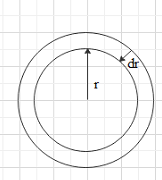
The excess pressure inside an air bubble of radius r just below the surface of water is ${{p}_{1}}$. The excess pressure inside a drop of the same radius just outside the surface is ${{p}_{2}}$. If T is the surface tension, then:
A). ${{p}_{1}}=2{{p}_{2}}$
B). ${{p}_{1}}={{p}_{2}}$
C). ${{p}_{2}}=2{{p}_{1}}$
D). ${{p}_{2}}=0,{{p}_{1}}\ne 0$
Answer
514.4k+ views
Hint: For a liquid drop we have only one surface. For an air bubble we have two surfaces. Define the mathematical expression for the excess pressure inside an air bubble and inside a liquid drop using the concept of surface tension. Take their ratio to find the answer to this question.
Complete step by step answer:
Consider an air bubble of radius r and surface tension T. we have two free surfaces in an air bubble. Due to the surface tension, the molecules of the surface experience a net inward force towards the centre and normal to the surface.

Let the outside pressure is ${{p}_{o}}$ and the inside pressure is ${{p}_{i}}$ .
So, the excess pressure will be $p={{p}_{i}}-{{p}_{o}}$
Due to the excess pressure inside the bubble will expand. Let the bubble expand by $dr$ .
So, the work done by the excess pressure will be.
$\begin{align}
& \text{work done = force }\times \text{ displacement} \\
& \text{work done = excess pressure }\times \text{ surface area }\times \text{ displacement} \\
& \text{work done = p}\times \text{4}\pi {{\text{r}}^{2}}\times dr \\
\end{align}$
Increase in potential energy is given by
$\begin{align}
& =\text{ surface tension }\times \text{ increase in surface area} \\
& =\text{ }T\times \left[ 2\left\{ 4\pi {{\left( r+dr \right)}^{2}}-4\pi {{r}^{2}} \right\} \right] \\
& =T\times 2\times 4\pi \times 2rdr \\
\end{align}$
Comparing these two equations we get that,
$\begin{align}
& p\times 4\pi {{r}^{2}}\times dr=T\times 2\times 4\pi \times 2rdr \\
& p=\dfrac{4T}{r} \\
\end{align}$
So, the excess pressure for an air bubble will be ${{p}_{1}}=\dfrac{4T}{r}$
Again, for a liquid drop we only have one free surface. Following the same procedure, we can find that the excess pressure for liquid drop is ${{p}_{2}}=\dfrac{2T}{r}$
Taking the ratio of these two quantities,
$\begin{align}
& \dfrac{{{p}_{1}}}{{{p}_{2}}}=\dfrac{\dfrac{4T}{r}}{\dfrac{2T}{r}}=2 \\
& {{p}_{1}}=2{{p}_{2}} \\
\end{align}$
The correct option is (A)
Note: While solving numerical related to this always remember that if we consider the a soap bubble or air bubble the excess pressure will be given as $\dfrac{4T}{r}$ and if we consider a liquid drop such as water drop the excess pressure will be given as $\dfrac{2T}{r}$.
Complete step by step answer:
Consider an air bubble of radius r and surface tension T. we have two free surfaces in an air bubble. Due to the surface tension, the molecules of the surface experience a net inward force towards the centre and normal to the surface.

Let the outside pressure is ${{p}_{o}}$ and the inside pressure is ${{p}_{i}}$ .
So, the excess pressure will be $p={{p}_{i}}-{{p}_{o}}$
Due to the excess pressure inside the bubble will expand. Let the bubble expand by $dr$ .
So, the work done by the excess pressure will be.
$\begin{align}
& \text{work done = force }\times \text{ displacement} \\
& \text{work done = excess pressure }\times \text{ surface area }\times \text{ displacement} \\
& \text{work done = p}\times \text{4}\pi {{\text{r}}^{2}}\times dr \\
\end{align}$
Increase in potential energy is given by
$\begin{align}
& =\text{ surface tension }\times \text{ increase in surface area} \\
& =\text{ }T\times \left[ 2\left\{ 4\pi {{\left( r+dr \right)}^{2}}-4\pi {{r}^{2}} \right\} \right] \\
& =T\times 2\times 4\pi \times 2rdr \\
\end{align}$
Comparing these two equations we get that,
$\begin{align}
& p\times 4\pi {{r}^{2}}\times dr=T\times 2\times 4\pi \times 2rdr \\
& p=\dfrac{4T}{r} \\
\end{align}$
So, the excess pressure for an air bubble will be ${{p}_{1}}=\dfrac{4T}{r}$
Again, for a liquid drop we only have one free surface. Following the same procedure, we can find that the excess pressure for liquid drop is ${{p}_{2}}=\dfrac{2T}{r}$
Taking the ratio of these two quantities,
$\begin{align}
& \dfrac{{{p}_{1}}}{{{p}_{2}}}=\dfrac{\dfrac{4T}{r}}{\dfrac{2T}{r}}=2 \\
& {{p}_{1}}=2{{p}_{2}} \\
\end{align}$
The correct option is (A)
Note: While solving numerical related to this always remember that if we consider the a soap bubble or air bubble the excess pressure will be given as $\dfrac{4T}{r}$ and if we consider a liquid drop such as water drop the excess pressure will be given as $\dfrac{2T}{r}$.
Recently Updated Pages
Why are manures considered better than fertilizers class 11 biology CBSE

Find the coordinates of the midpoint of the line segment class 11 maths CBSE

Distinguish between static friction limiting friction class 11 physics CBSE

The Chairman of the constituent Assembly was A Jawaharlal class 11 social science CBSE

The first National Commission on Labour NCL submitted class 11 social science CBSE

Number of all subshell of n + l 7 is A 4 B 5 C 6 D class 11 chemistry CBSE

Trending doubts
Differentiate between an exothermic and an endothermic class 11 chemistry CBSE

10 examples of friction in our daily life

One Metric ton is equal to kg A 10000 B 1000 C 100 class 11 physics CBSE

Difference Between Prokaryotic Cells and Eukaryotic Cells

1 Quintal is equal to a 110 kg b 10 kg c 100kg d 1000 class 11 physics CBSE

State the laws of reflection of light




